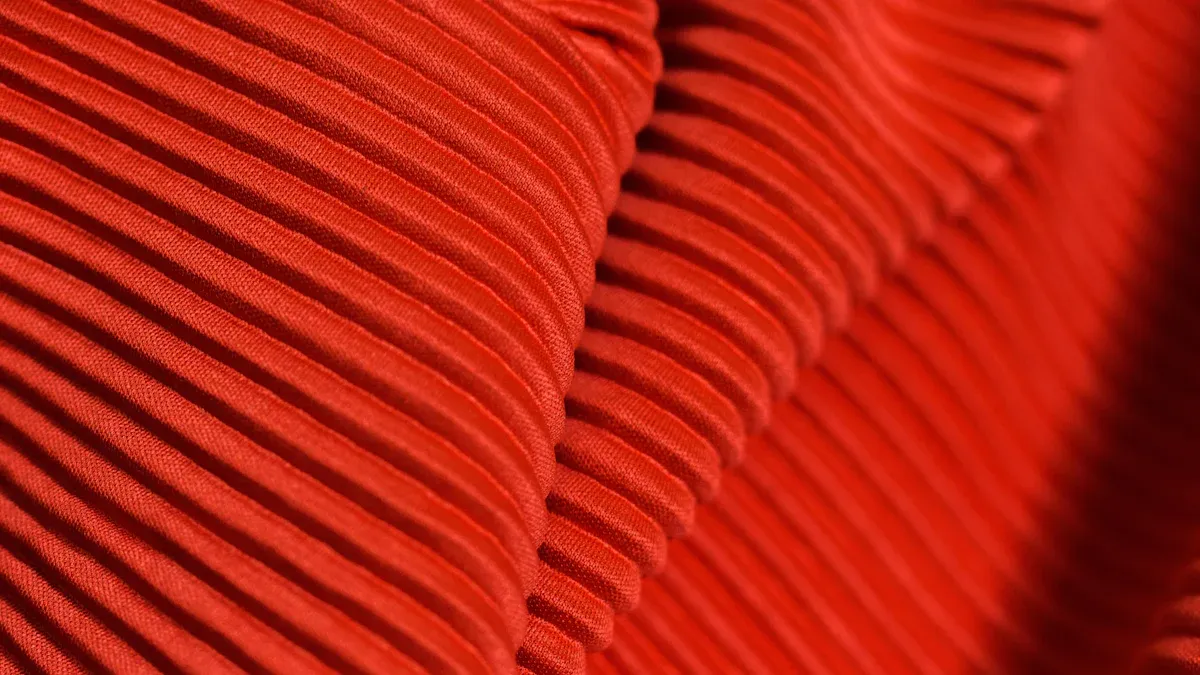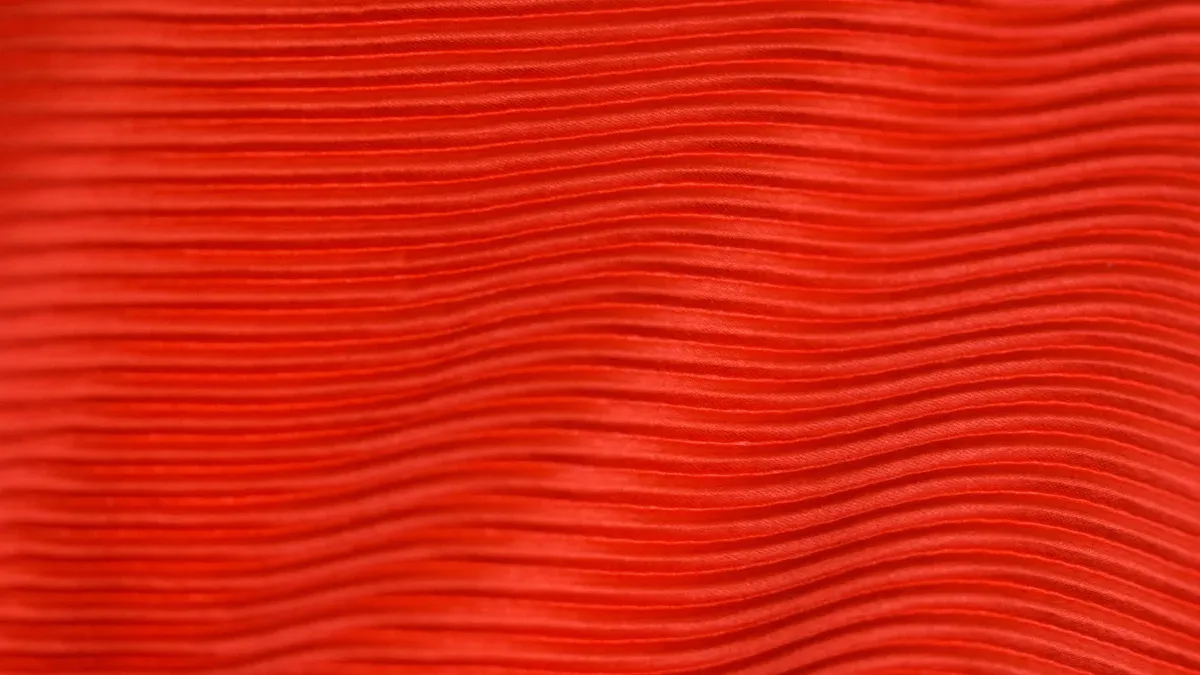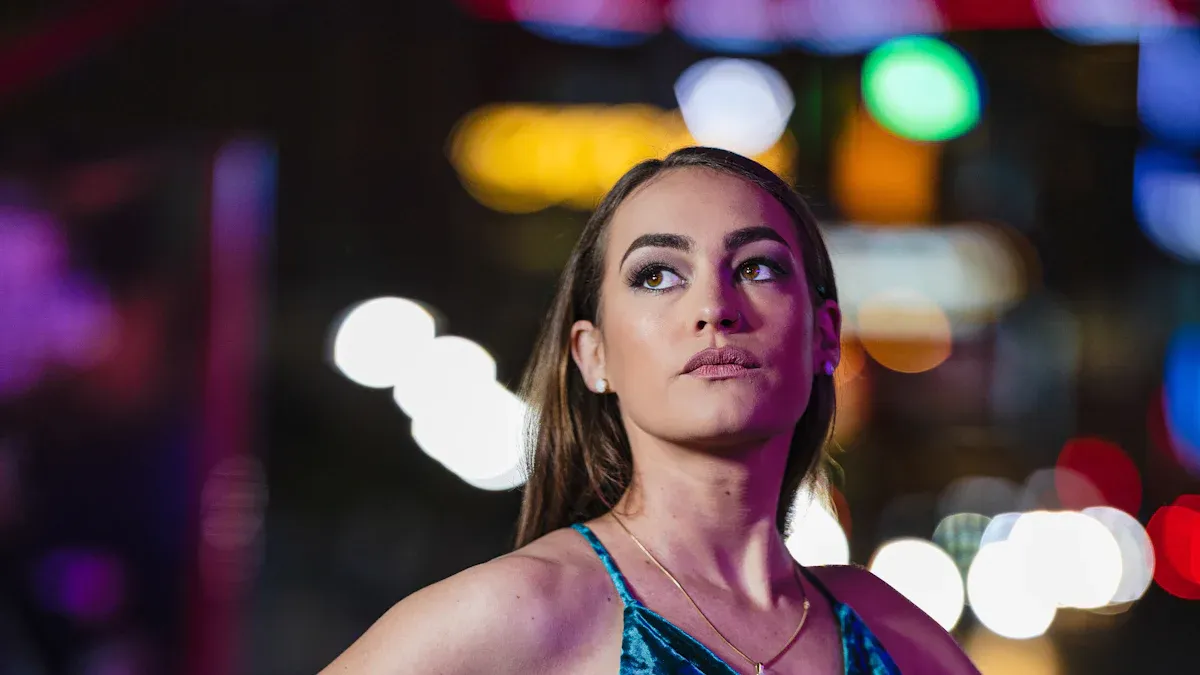
Ribbed fabric usually does not fray. You can trust rib knit fabric for your sewing and fashion projects. The unique rib knit structure uses loops that hold the threads together. This makes rib knit fabric strong and flexible. When you cut rib knit, the edges stay neat. Many people choose rib knit because it keeps its shape, even after many washes. Suerte’s rib knit fabric gives you comfort and durability. You can use rib for cuffs, collars, or even full garments with confidence.
Key Takeaways
- Ribbed knit fabric does not fray easily. Its looped structure keeps threads together. This helps the edges stay neat after you cut them.
- Woven fabrics can fray, but ribbed fabric does not. You do not need to finish the edges to stop fraying. This makes ribbed fabric quicker and easier to use.
- Use sharp scissors when you cut ribbed fabric. Pattern weights help hold the fabric in place. Do not stretch the fabric while cutting. This keeps the edges clean and the shape correct.
- Sew ribbed fabric with a ballpoint needle. Use stretch stitches like zigzag or a serger. This gives you strong and flexible seams.
- Suerte’s ribbed knit fabric is strong and comfortable. You can also customize it. It works well for cuffs, collars, and whole clothes.
Explanation of What Fraying Means in Fabrics
What Is Fraying
You might notice loose threads at the edge of some fabrics. This is called fraying. When you cut a piece of fabric, the threads can start to come apart. Fraying happens most often in woven fabrics. These fabrics have threads that cross over and under each other. When you cut them, the threads at the edge can slip out. This makes the edge look messy and weak. Fraying fabrics can lose their shape and strength over time. You want to avoid fraying because it can ruin the look and feel of your project. Ribbed knit fabric, like Suerte’s, resists fray because of its special structure. You can cut ribbed fabric and see that the edges stay neat. This makes ribbed fabric a great choice for sewing.
Why Fabrics Fray
Fraying fabrics happen for many reasons. The way a fabric is made plays a big part. Woven fabrics fray more because their threads are only held together where they cross. When you cut them, the threads at the edge can slip out easily. Knit fabrics, like ribbed knit, use loops to hold the threads together. This looped structure helps stop fray from happening.
Textile experts say several things can cause fraying fabrics:
- Natural fibers, such as cotton and wool, tend to fray more. Their threads are softer and come apart more easily.
- Loosely woven fabrics are more likely to fray than tightly woven ones.
- Using dull scissors or rough handling can make fraying worse.
- Sewing with the wrong machine settings, like tight stitches, can cause fraying fabrics.
- Changes in humidity and temperature can weaken fibers, leading to fray.
- Regular use and washing wear down fibers, making fraying fabrics more common.
You can see that fraying fabrics are a problem for many projects. If you want your work to last, you need to choose materials that resist fray. Ribbed knit fabric stands out because it keeps its edges clean. You do not have to worry about fraying fabrics when you use ribbed knit for your next project.
Ribbed Fabric Structure and Fraying

Unique Knit Construction of Ribbed Fabric
You might wonder what makes rib knit fabric so special. The answer lies in how you create rib knit fabric. When you look closely, you see that rib knit fabric uses a series of loops. These loops form vertical ridges, which you call ribs. Each rib comes from alternating knit and purl stitches. This pattern gives rib knit fabric its signature texture and stretch.
At the microscopic level, rib knit fabric shows a double-faced, double-knit structure. You find vertical rows of knit and purl stitches on both sides. This double-knit construction makes rib knit fabric thicker and more stable than single knits. The fabric does not curl at the edges, and it keeps its shape well. The vertical ribs allow rib knit fabric to stretch in many directions and snap back to its original form. Tuck stitches in the fabric help it recover after you stretch or pull it.
Here are some key features of rib knit fabric’s structure:
- Alternating knit and purl stitches create strong vertical ribs.
- Double-knit construction adds thickness and stability.
- The fabric stretches and recovers easily, keeping its shape.
- Tuck stitches improve recovery after stretching.
- The compact rib pattern resists abrasion and bursting.
- Rib knit fabric shows high stretch percentages and minimal shrinkage.
You can see why rib knit fabric stands out for durability and flexibility. Suerte’s rib knit fabric uses advanced circular knitting machines. This technology removes side seams, which are weak spots in many fabrics. You get a smooth, seamless finish that feels comfortable and lasts longer.
Why Ribbed Fabric Offers Exceptional Fray Resistance Compared to Other Materials
You may ask why rib knit fabric resists fray so well. The answer comes from the way you make rib knit fabric. Unlike woven fabrics, which use threads that cross over and under each other, rib knit fabric uses interlooping yarns. When you cut rib knit fabric, the loops stay together. The edges might curl, but they do not fray in the traditional sense. You do not see loose threads coming apart.
Let’s compare rib knit fabric and woven fabric:
| Feature | Rib Knit Fabric | Woven Fabric |
|---|---|---|
| Construction | Interlooping yarns (loops) | Interlacing warp and weft threads |
| Edge Behavior | Edges curl, do not fray | Edges fray, threads separate |
| Need for Edge Finishing | Often optional | Usually required |
| Stretch and Recovery | High stretch, snaps back easily | Limited stretch |
You do not need to finish the edges of rib knit fabric to prevent fray. This makes rib knit fabric easy to work with, especially for beginners. You can cut rib knit fabric for cuffs, collars, waistbands, or full garments and trust that the edges will stay neat.
Suerte’s premium rib knit fabric takes fray resistance to the next level. The fabric uses four-way stretch materials that resist abrasions and tears. Suerte checks every batch with strict quality control. The company uses up to 40% more inspection points than standard brands. Tests like the Martindale abrasion test and stretch recovery assessments prove the fabric’s strength. Suerte’s rib knit fabric passes pilling and snagging tests at a high level, so you know it will last.
You can also customize Suerte’s rib knit fabric. Choose from different materials, colors, weights, and designs. Suerte offers options like jacquard, printed, brushed, and dyed rib knit fabric. You get the look and feel you want, plus the confidence that your rib knit fabric will not fray.
Tip: When you use Suerte’s rib knit fabric, you save time because you do not need to finish the edges. You also get a fabric that keeps its shape and looks great, wash after wash.
Tips for Handling and Sewing Ribbed Fabric
Essential Cutting Tips for Working with Ribbed Fabric
Cutting ribbed knit fabric can be easy if you follow a few expert tips. You want your pieces to stay neat and keep their shape. Here are some steps you can use:
- Prewash your ribbed knit fabric before cutting. This helps prevent shrinkage later.
- Lay the fabric flat on a smooth surface. This keeps the fabric stable and stops it from stretching.
- Use pattern weights instead of pins. Weights hold the fabric in place without making holes or causing it to shift.
- Choose sharp fabric scissors or a rotary cutter with a cutting mat. These tools give you clean, straight edges.
- Pin or clip the edges if they start to curl. This makes cutting easier and keeps your lines straight.
- For pieces cut on the bias, use fusible interfacing or spray starch. This helps prevent stretching and distortion.
Tip: Avoid pulling or stretching the fabric while you cut. This keeps your edges smooth and helps prevent fraying edges.
Best Practices for Sewing and Finishing Edges on Ribbed Fabric
When you sew ribbed knit fabric, you want strong seams that stretch with the fabric. Here are some best practices:
- Use a ballpoint needle. This type of needle slides between the knit loops and prevents damage.
- Choose stretch or polyester thread. These threads move with the fabric and keep seams from breaking.
- Select a zigzag stitch, stretch stitch, or use a serger (overlock machine). These stitches allow the seam to stretch and help prevent fraying.
- Adjust your machine’s tension and stitch length. This stops puckering and keeps your seams flat.
- Try a walking foot if your fabric stretches or shifts. This foot feeds both layers evenly.
- Finish raw edges with a serger or zigzag stitch for a clean, professional look. Edge finishing is often optional with ribbed knits, but it adds neatness.
- Practice on scrap fabric to test your settings and stitches.
You can also use pinking shears or iron-on hem tape for crafts or special projects. For most garments, serging or zigzag stitches work best.
Suerte supports you every step of the way. You get access to design support, care tips, and advanced technology for the best results. Here is a quick look at Suerte’s support resources:
| Support Resource | Description |
|---|---|
| Sample Verification & Design Support | Fast sample checks and expert help to bring your ideas to life. |
| Care Tips | Advice on washing, drying, and storing your ribbed knit fabric. |
| Customization Options | Choose your material, color, and design for a perfect match. |
| Contact Information | Reach out for help or questions at any time. |
Note: Suerte’s experts are always ready to guide you, so you can achieve professional results with every project.
You can count on ribbed fabric for many projects. Suerte’s ribbed knit fabric is a good choice. It does not fray and keeps its shape well. The fabric feels soft and nice on your skin. Sewing with it is simple and caring for it is easy. This makes it great for winter pyjamas, sportswear, and daily clothes.
- Stretches and goes back to shape
- Feels soft and keeps you warm
- Good for cuffs, collars, and whole clothes
Suerte’s ribbed knit fabric lets you make stylish, strong clothes you can trust.
FAQ
Will ribbed fabric fray if I cut it?
You do not need to worry about fraying when you cut ribbed fabric. The knit loops hold the threads together. The edges may curl, but you will not see loose threads coming apart.
Do I need to finish the edges of ribbed knit fabric?
You often do not need to finish the edges of ribbed knit fabric. The structure keeps the edges neat. You can add a finish for a cleaner look, but it is not required for most projects.
Can I use ribbed knit fabric for winter pyjamas?
You can use ribbed knit fabric for winter pyjamas. The fabric feels soft and stretches well. It keeps you warm and comfortable. Many people choose ribbed knit for cozy sleepwear and loungewear.
What is the best way to sew ribbed knit fabric?
You should use a ballpoint needle and stretch thread. A zigzag stitch or a serger works best. These tools help the seams stretch with the fabric. Always test your settings on a scrap piece first.
How do I stop ribbed fabric from curling at the edges?
You can use pins or clips to hold the edges flat while you work. Pressing the fabric with a warm iron can also help. If you want, you can add a simple hem to keep the edges straight.



